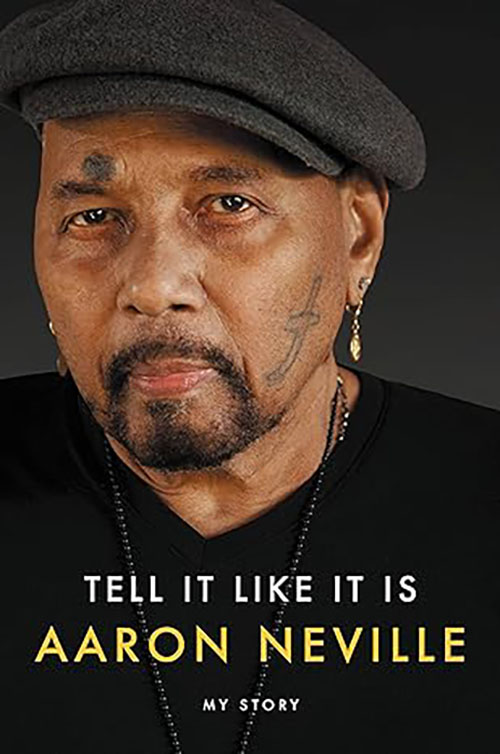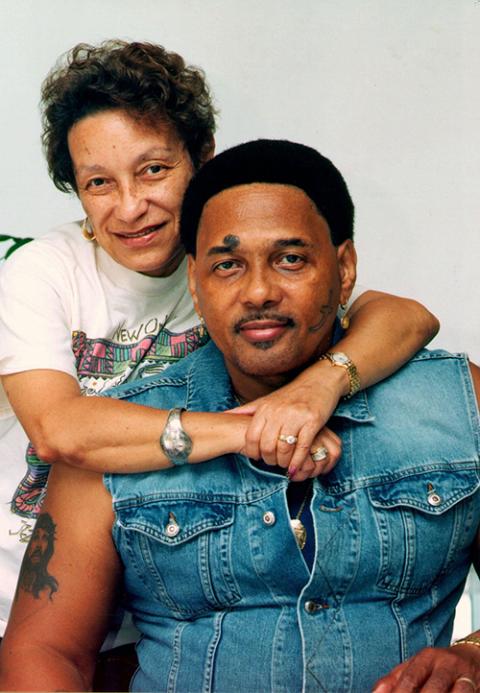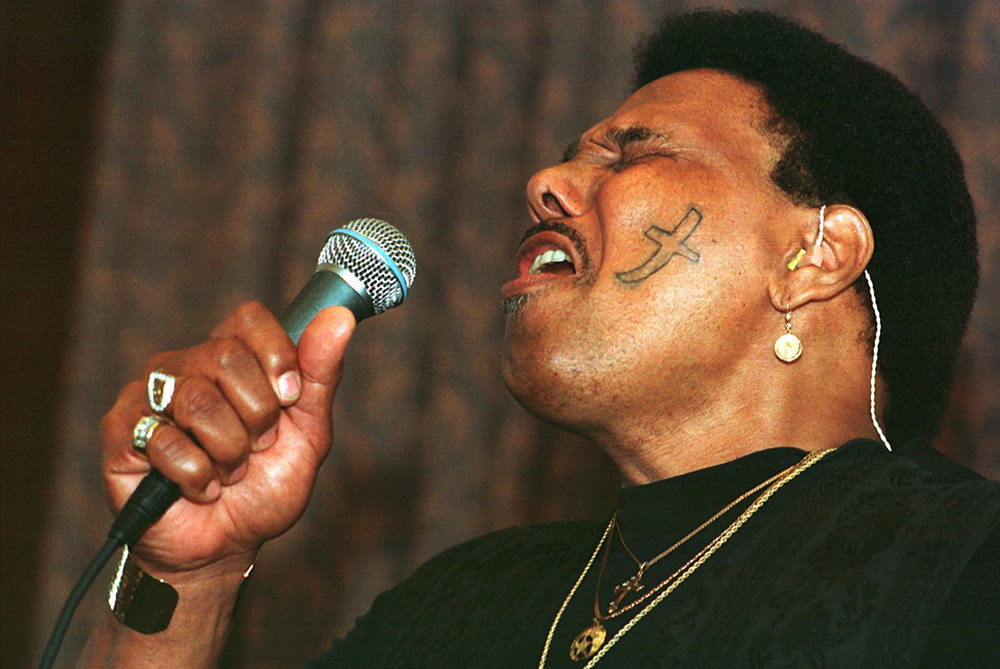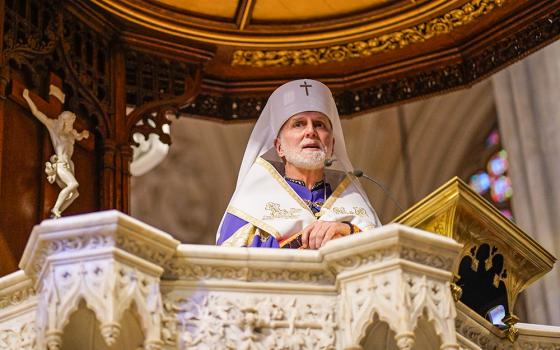
Aaron Neville performs at the New Orleans Jazz and Heritage Festival on May 4, 2019, in New Orleans. (AP/Invision/Amy Harris)

On a balmy afternoon in 1979, I interviewed New Orleans rhythm-and-blues singer Aaron Neville under his favored tree by the Audubon Park lagoon. He came ambling down the park road in gym shorts, track shoes and a tank top, looking more like a fullback than a vocalist raised on doo-wop who loved singing "Ave Maria."
Of the dagger tattoo covering his left cheek, he said freely, "Some people see me and think I look thuggish." In the next breath he spoke about his daily prayers and reliance on St. Jude. With a fleeting reference to the shackles of a drug addiction, he said, "Believe me, bro, I was a hopeless case."
Advertisement
The International Shrine of St. Jude occupies a corner of Our Lady of Guadalupe Church on N. Rampart Street in New Orleans. At the time of that long-ago interview, Neville took Jonathan Foose, my colleague on a book project, to the shrine. Foose, a lanky chap raised in the big house on a Mississippi delta plantation, was awestruck at the burning candles and sounds of some people sobbing as they prayed. Neville nudged him: "You got to kneel for the dude, Jude." Foose, raised an Episcopalian, got down on his knees on the marble floor next to Neville.
Quite a number of musicians have found their way to the shrine. One of them, pianist A.J. Loria, oversaw the recording of "Midnight at St. Jude's", a Mass featuring Neville and Loria, along with Allen Toussaint, Mighty Sam McClain, Lady B.J. and Edgar Blanchard. All of those artists have since passed away, save for Neville, now 82.
St. Jude's role in Neville's life flickers through his new memoir, Tell It Like It Is: My Story. The acknowledgements' first line reads: "I want to first thank the Lord Jesus and St. Jude Thaddeus, the saint of impossible and hopeless cases." Roughly half of the book recounts in graphic detail his years of addiction, the strange ritual attraction of heroin, collisions with cops, stretches behind bars and the unstinting love of his wife, Joel — pronounced Jo-el. He was 18 when they married, their first baby on the way. She died of cancer shortly before their 48th anniversary.

Singer Aaron Neville and his wife, Joel, are pictured in a 1998 photo. (CNS/Clarion Herald/Frank Methe)
Neville had a huge hit in 1966 with the tender ballad, "Tell It Like It Is," but the money never materialized; he took work on the Mississippi docks, unloading cargo to support his family. He kept performing and recording, drugging and running till rocket fuel came in 1977 with the formation of The Neville Brothers band. Art, the oldest brother with past hits of his own ("Mardi Gras Mambo" and "All These Things") guided the starship on keyboard with Charles on an ethereal tenor sax, Aaron with the soaring octaves and Cyril the youngest on conga drums and vocals. The Nevilles had one serious front line: strapping guys in rolling, four-part harmonies, singing chants of the Mardi Gras Indians, doo-wop, rock and more at Tipitina's music club, jam-packed shows that often ran till dawn.
The Nevilles became rock royalty, touring with The Rolling Stones, and playing at Grateful Dead concerts. They traveled 300 days a year, often with New Orleans legends Professor Longhair, Dr. John, Irma Thomas and Allen Toussaint.
In his memoir, Neville's story unfolds in the vernacular voice of a man across the kitchen table, unspooling tales and memories of musical glories, racist cops, the raw side of the streets, life behind bars and the slow uphill road to salvation, with great credit given to Joel, and his second wife, photographer Sarah Ann Friedman — a narrative feat for which he duly thanks collaborator Beth Adelman for assistance. (A pity she failed to use capital letters in writing about Charity Hospital, an iconic institution in many musicians' lives, in several references to the hospital in the book. The high-octane vocalist Ernie K-Doe in the 1980s had a show on WWOZ FM, the community radio station, in which he began by "calling all the Charity Hospital babies within the sound of my voice," and waxing on the night he was born there.)

Aaron Neville performs for a gathering of the Catholic Press Association in New Orleans in June 1998. (CNS/Nancy Wiechec)
As the crashes, incarcerations and near-misses accelerate in Neville's story, his depth of character, shaped by loving parents and a Catholic schooling experience he considers largely positive, achieves a powerful poignance at telling moments:
Yes, I wanted to be famous, but it was a lot more than that. Singing purified me. When I was onstage I was closest to my true self, closest to God. My heart turned inside out so everyone could hear what was in it. When I wasn't singing, I was an angry, drugged-out thug with a voice like an angel but no reason to be one.
A few pages later, he goes deeper:
I was sitting in the gutter in front of an area I used to call the snake pit —- three dive bars on Lyons Street. I was in a bad way, confused, and all of a sudden I thought of 'Ave Maria.' I had first heard it at St. Monica's School when the choir would sing it at mass. ... I never knew what the words meant until later — it was in Latin — but every time I heard it, it did something to my heart and soul. And later in life it became a light at the end of the tunnel for whatever I was going through. I would get a cleansing feeling.
The beauty of Aaron Neville's great falsetto reach and heart-pulsed phrasing led to sensational duets in 1989 with Linda Ronstadt, "Don't Know Much" and "All My Life" for which they shared Grammy awards. (He has five in all, including ones with the Neville Brothers.)
In 2015, Neville received the Laetare Medal for service to the faith at University of Notre Dame's graduation ceremony.
Hurricane Katrina destroyed his house in the eastern suburbs of New Orleans; he moved his family to Nashville, and after Joel's death, found rejuvenation with Friedman. They moved to New York City, then to a farm in Hudson Valley. When COVID-19 hit, Neville retired from touring.
Most of Neville's fans, I suspect, can point to a moment of exaltation in hearing that angelic voice, a memory made from a given song. I haven't seen Aaron in years. Reading his account of the broken mud town post-Katrina, I thought of late fall 2005 when my mother and younger daughter stayed for stretches at my house, among the 20% that didn't flood. Ariel, who died of heart failure in 2008, was a child with Down syndrome, then 15, deeply curious about the city's survival. We drove through flood-battered neighborhoods playing "Believe," Neville's gospel CD, in the car; the lead cut, "Steer Me Right," may be his most autobiographical. With a bouncing Caribbean beat, those golden pipes begin:
Steer me right, sweet Jesus
Steer me right, don't let me fall
Steer me right, steer me right, sweet Jesus
Be my all in allI've been runnin' behind a train
I never could keep satisfied
Appetite for destruction
Keeps a man bound and tiedOh, shine your goodness down on me
Oh Lord from up above
In my darkest hour
Soon be, it's Your turn to love
In his memoir, Neville's story unfolds in the vernacular voice of a man across the kitchen table, unspooling tales and memories of musical glories, racist cops, the raw side of the streets, life behind bars and the slow uphill road to salvation.
Many houses in those crushed neighborhoods had blue tarpaulins on the roof, courtesy of FEMA, which had so bungled the early phase of the emergency as to earn the hatred of many people. Ariel couldn't read, but she understood a lot; when I explained that FEMA put on the blue rooftop sheaves, she was bouncing in the seat, singing "steer me right ... sweet Jesus," interrupted by jubilant exclamations of "FEMA! FEMA — look dad, they workin'." Yes, honey, they are rebuilding.
"Steer Me Right" became a fixture on the turntable in the dining room bookcase, a song she sang repeatedly that first Carnival season after the flood in early 2006, dancing around the table, swirling plastic beads thrown from the parade floats, singing "steer me right … don't let me fall." I still carry that CD — and Aaron Neville's ethereal voice — in the car. I still play it at home, a memory loop of my sweet, departed child.








